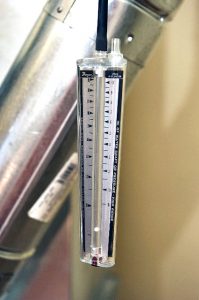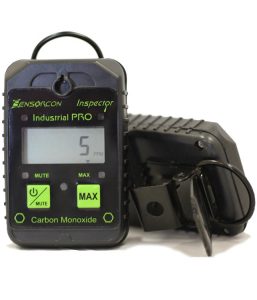Many technicians get distressed when they measure draft pressure in the flue and discover the reading is zero. Let’s look at three common reasons for zero draft pressure in a flue. We’ll also determine what defect you’re dealing with.
Reason #1: Zero Draft from Building Depressurization
Building depressurization is probably the most common reason for zero draft pressure. Depending on the source, depressurization can occur randomly or continuously. The pressure needed to allow flue gases to exhaust equipment as designed are fragile and easily influenced.
Air competes for ways to make it in or out of a building. When depressurization occurs, air is pulled in from the easiest location to compensate for air being exhausted. It’s unfortunate the easiest location is often a duct intended for the removal of flue gases.
Common sources of depressurization include:
- Exhaust fans (Kitchen exhaust, clothes dryers, radon mitigation fans, powered attic ventilators, etc.)
- HVAC-related airflow imbalances (duct leakage, central returns, interior door closure, airflow imbalances, and any airflow that negatively affects the equipment)
- Building stack effect.

A draft gauge, also known as an air meter is indispensable for measuring draft in appliance flues. By using NCI’s protocol you can accurately measure and diagnose flue problems with this tool. Use on standard, mid, and high-efficiency furnaces, boilers, and water heaters.
Room pressure testing provides clues to these issues, but draft pressure testing is the most effective way to determine the impacts. It is important to assure no fans are operating and measure draft pressure with only the equipment operating to establish a baseline value.
As you measure draft pressure, start sequentially turning on different fans, starting with the largest. Watch the draft pressure. When it drops, you found the guilty fan. If you turn on the appliance and measure zero draft from the start, you might be dealing with a restricted flue instead of depressurization.
Reason #2: Zero Draft from a Restricted Flue
Equipment with no draft from the beginning could be tied to a flue that is restricted or completely blocked. Conditions like this are why it’s so important to measure ambient carbon monoxide (CO) for your personal safety. If the equipment is producing high levels of CO, and the flue is restricted, you might not walk out of the mechanical room.
In this situation, there could be debris blocking the flue due to deterioration or an animal nest. These are clues that much bigger issues exist. They are typically symptoms, not causes. Digging a little deeper with a visual inspection will uncover this problem quickly.
Another restriction rarely considered is a flue liner. These are required by code in many parts of the country and can cause more issues than they solve when sized or installed incorrectly. If the liner is kinked or undersized, you can expect to encounter flue gas spillage as you would with a blocked flue, except everything looks great with a visual inspection.
To determine if you’re dealing with a restricted flue, shut off gas to the equipment and watch for an increase in draft pressure. If it moves upward within a minute of turning the fuel off, you have a flue restriction that to investigate.
Reason #3: Zero Draft During Summer Water Heater Operation
One of the most deceptive situations you can encounter with no draft is water heater operation in the summer time. You’ll often find no signs of spillage when this condition exists, even though the ball of the draft gauge is sitting at the bottom, not moving.
It may be hard to believe, but this condition could be acceptable even though it looks quite the opposite. When the heat of the summer turns up, there is less temperature difference between the flue gases and outside than there is in the winter time. Due to this, draft pressure can drop so low that it is virtually undetectable.
If you encounter this situation, you’ll have to rely on measuring multiple CO readings in the flue gas to tell you if the water heater is safe or not. If CO readings are stable during the run cycle, the equipment is venting correctly. When CO readings continue rising during the run cycle, it can mean improper flue gases venting. This is one of the previous reasons to investigate a no-draft situation.
Telling the Difference
While this isn’t an all-inclusive list of reasons for no draft, it’s a starting point for the most common ones. It’s important to remember draft pressure is not the determining factor in whether flue gases properly leave the equipment or not.
You can use some subtle differences between all three reasons to help you uncover the source. Reasons 1 and 2 often show signs of spillage around the draft hood. This requires a draft interference test and/or restricted flue test to distinguish between them. Stable CO readings are the only indicator that number 3 is a reason. Without them, you’ll probably misdiagnose the problem.
The answers are out there, together we will find them. If you need any additional information on this material or have any questions, feel free to e-mail me at doccombustion@gmail.com.


